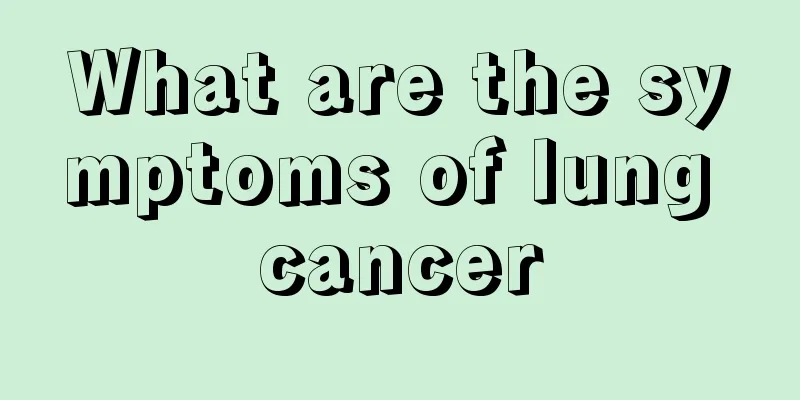What are the symptoms of lung cancer

|
When we hear the word cancer, we all get scared. Lung cancer is a common type. The occurrence of lung cancer has harmed many friends and also affected their lives. This disease can cause patients to have severe coughing symptoms, which will endanger their lives for a long time. There are many symptoms after the onset of lung cancer. Let us get to know the related symptoms of lung cancer. 1. Cough. Cough is the most common symptom, accounting for 35% to 75% of patients with cough as the first symptom. Cough caused by lung cancer may be related to changes in bronchial mucus secretion, obstructive pneumonia, pleural invasion, atelectasis and other intrathoracic complications. When the tumor grows in the bronchial mucosa above the segment with a larger diameter and sensitive to external stimuli, it can cause cough similar to that caused by foreign body stimulation. The typical manifestation is paroxysmal irritating dry cough, which is often difficult to control with general cough suppressants. When the tumor grows in the smaller bronchial mucosa below the segment, the cough is often not obvious or even absent. For patients who smoke or suffer from chronic bronchitis, if the cough becomes more severe, the frequency changes, and the nature of the cough changes, such as a high-pitched metallic sound, especially in the elderly, be highly alert to the possibility of lung cancer. 2. Blood in sputum or hemoptysis. Blood in sputum or hemoptysis is also a common symptom of lung cancer. About 30% of patients have this as the first symptom. Because tumor tissue is rich in blood supply and brittle in texture, blood vessels rupture and cause bleeding during severe coughing. Hemoptysis may also be caused by local tumor necrosis or vasculitis. The characteristics of lung cancer hemoptysis are intermittent or continuous, repeated small amounts of blood in sputum, or small amounts of hemoptysis. Occasionally, it is difficult to control large hemoptysis due to rupture of larger blood vessels, large cavities, or tumor rupture into the bronchial and pulmonary blood vessels. 3. Chest pain. About 25% of patients have chest pain as the first symptom. It often manifests as irregular dull pain or pain in the chest. In most cases, peripheral lung cancer invades the parietal pleura or chest wall, which can cause sharp and intermittent pleural pain. If it continues to develop, it will evolve into constant drilling pain. Mild chest discomfort that is difficult to locate is sometimes related to central lung cancer invading the mediastinum or involving blood vessels and peripheral bronchial nerves, and 25% of patients with malignant pleural effusion complain of dull chest pain. Continuous, sharp and severe chest pain that is not easily controlled by drugs often indicates that there is extensive pleural or chest wall invasion. Persistent pain in the shoulder or chest and back indicates that there may be tumor invasion near the mediastinum on the inner side of the lung lobe. 4. Chest tightness and shortness of breath. About 10% of patients experience this as the first symptom, which is more common in central lung cancer, especially in patients with poor lung function. The main causes of dyspnea include: ① In the late stage of lung cancer, when the mediastinal lymph nodes are widely metastatic and compress the trachea, carina or main bronchi, shortness of breath or even suffocation may occur. ② When a large amount of pleural effusion compresses the lung tissue and causes severe displacement of the mediastinum, or when there is pericardial effusion, chest tightness, shortness of breath and dyspnea may also occur, but the symptoms can be relieved after fluid extraction. ③ Diffuse bronchioloalveolar carcinoma and bronchial disseminated adenocarcinoma reduce the respiratory area and cause gas diffusion dysfunction, leading to severe ventilation/perfusion ratio imbalance, causing dyspnea to gradually worsen, often accompanied by cyanosis. ④ Others: including obstructive pneumonia. Atelectasis, lymphangitic lung cancer, tumor microembolism, upper airway obstruction, spontaneous pneumothorax and combined chronic lung diseases such as COPD. Lung cancer is a common disease at present, and it is also very prevalent among cancers. The harmfulness of this disease cannot be underestimated. In life, we need to be vigilant about the occurrence of lung cancer and actively do some work to prevent lung cancer. |
<<: What are the dangers of cervical cancer
>>: What should you avoid eating for small cell lung cancer
Recommend
Is cupping good for chronic gastritis?
Cupping is a health-preserving method that many p...
Why do I always lose a lot of hair
Everyone loses hair every day. From a physiologic...
Experts say the main early symptoms of melanoma are as follows
Melanoma is a common disease, and melanoma patien...
What to pay attention to after bladder cancer surgery
After bladder cancer surgery, you should pay atte...
Will washing your face with fluoride-containing water cause acne?
The most annoying thing for everyone is acne on t...
What are the causes of fatty liver? Treatment principles to be followed for fatty liver
Most people think that fatty liver is caused by e...
What to do if your ears are frozen and itchy
Winter is the coldest season of the year, especia...
The chest muscles on both sides are not the same size after fitness
Some people still find that the size of their che...
What does hair oil mean
Hair treatment is actually a method of hair dyein...
What are the early clinical manifestations of shock?
The occurrence of shock needs to be taken serious...
What are the targeted drugs for treating advanced gastric cancer
What are the targeted drugs for treating advanced...
Can cafe au lait spots be removed?
Many people have found some coffee-colored spots ...
What to use for dry skin on legs
In autumn, we will wear long johns, but before go...
5 Practical Life Skills of Vinegar
Washing your hair with vinegar makes it smoother ...
Contraindications for medication for endometrial cancer
What are the contraindications for endometrial ca...









